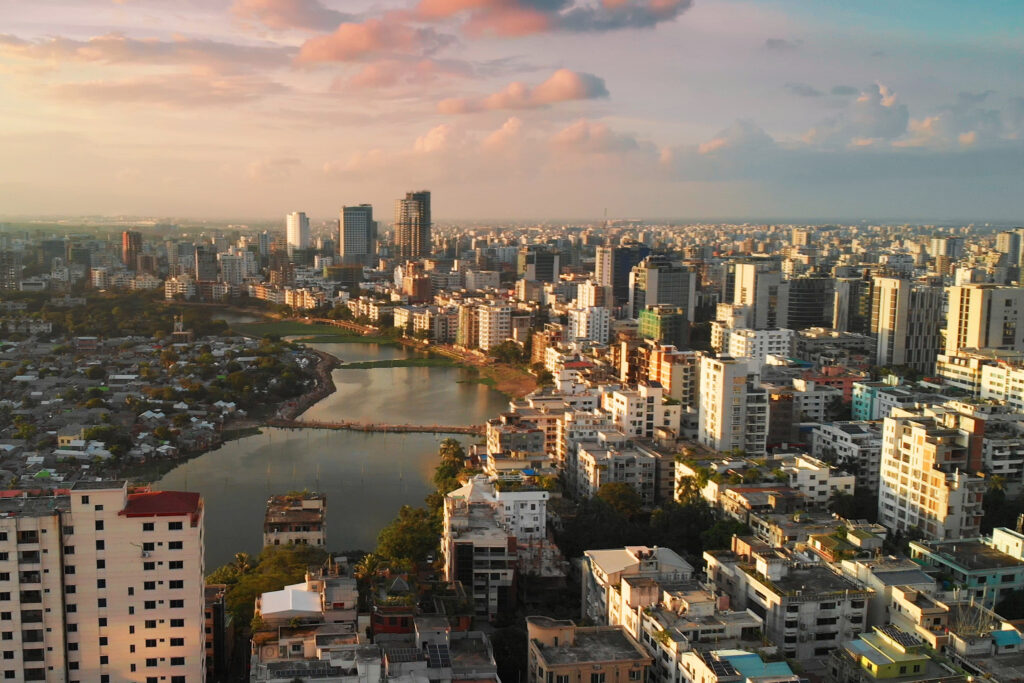Bangladeshi Americans redefining the American Dream and the perception of identity

By Rashed Rabbi
September/October 2022
Although I couldn’t feel the pain,
I knew I had to try.
Now I’m asking all of you
To help us save some lives
Bangla Desh, Bangla Desh
Where so many people are dying fast
And it sure looks like a mess
I’ve never seen such distress
Now won’t you lend your hand and understand
Relieve the people of Bangla Desh.
In August 1971, The Beatles lead guitarist George Harrison performed a number titled “Bangla Desh” in New York’s Times Square to bring awareness about the massacre being perpetrated in East Pakistan (now Bangladesh). At that time the most popular ex-Beatle, Harrison put his popularity on the line to acknowledge Bangladesh as a sovereign nation for the first time to the American public.
Ever since independence — a move triggered in reaction to actions taken by West Pakistan-based power centers — earned with blood and countless deaths, the rise of this war-torn country was further fraught by natural calamities for almost two decades before it secured an international reputation for exporting the highest quality of jute (the “golden fiber”) and the large quantity of garments throughout the late 20th century. Since then, its development trajectory boasts such a “unique success story” (The Asia Foundation, June 25, 2014) that it earned the distinction of “role model” (Arab News, July 22).
However, Bangladeshi immigrants to the U.S. still suffer from an unfavorable or invisible image, which is quite distressing and hurtful to their sense of identity.
Some Sparks to Eliminate Invisibility
Despite facing formidable obstacles to acceptance and success, the Bangladeshi American diaspora demonstrates its steady pursuit of the American Dream through leadership, careers in high-skill occupations, entrepreneurship, literature and research.
For example, in 2006 Rep. Hansen Hashim Clarke (D), who was raised by a Bangladeshi father, was elected to represent Michigan’s 13th Congressional District — the first Bangladeshi-American to do so. He served three terms and two four-year terms in the State Senate. Since then, many have pursued success in U.S. politics.
Today, Yale graduate Zayn Siddique serves as White House Senior Advisor to the Deputy Chief of Staff. Born and raised in Kensington, Brooklyn, Shahana Hanif, a daughter of Bangladeshi immigrants, represents Brooklyn’s 39th District in the New York City Council.
Jawed Karim, of Bangladeshi-German descent and an American software engineer, is one of YouTube’s three cofounders. Imran Khan, who originally came as a foreign student, served as a chief strategy officer at Snap Inc., Snapchat’s parent company, from 2015 to 2018. He was tasked with building up revenue, expanding the business, running ad sales and charting a course to an initial public offering.
In 2008, Salman Khan of Bangladeshi-descent founded the renowned Khan Academy, which features 3,400 short instructional videos along with interactive quizzes and tools to promote “a free world-class education for anyone anywhere.” Ernst and Young named Mahfuz Ahmed (CEO, DISYS) its 2013 Entrepreneur of the Year of the Greater Washington D.C. Region. Omar Ishrak, who became CEO of Medtronic in 2011, has been Intel chairman since 2020.
Jennifer Lopez was highly applauded for partnering with Muhammad Yunus’ Grameen America, a microfinance organization, to empower Latina entrepreneurs across 50 U.S. cities with $14 billion in business capital and 6 million hours of financial education and training by 2030. Yunus, winner of the 2008 Nobel Peace Prize, lives and works in Bangladesh.
From the world of literature, novelist and critic Rumaan Alam was featured on former President Barack Obama’s 2021 summer reading list for his latest book, “Leave the World Behind.”
These names are just a few of the sparks in the diaspora that are debunking Bangladesh’s invisibility. The blank stares or ill-informed queries and opinions have become far less frequent when someone states proudly “I’m from Bangladesh.”
Due to the diaspora’s continued contribution, in 2010 the City of Los Angeles designated a four-block area around 3rd St. and Alexandria Ave. in Central Los Angeles, as “Little Bangladesh.” There are similar visible Bangladeshi communities Hamtramck, Mich., Arlington, Va., as well as in Brooklyn and Queens, N.Y. These accomplishments are gradually eliminating the country’s invisibility, which caused this ethnic minority to experience an unexpected homogenizing and even stigma in the U.S.
A Quick History and Demography
MIT historian Vivek Bald has traced migration from the region that became Bangladesh to the U.S. since the 19th century. These numbers remained low throughout the 1970s, when a small number of Bangladeshis arrived as workers, students and political asylum seekers. A trickle of immigrants continued until the Diversity Visa Lottery of the early 1990s, when thousands immigrated on green cards. Since the beginning of the new millennium, most Bangladeshi immigrants have been skilled professionals and graduate students, which makes the diaspora far more diverse and vibrant.
According to the U.S. census, in 1980 there were 5,800 Bangladeshis — a number that grew very fast in the following decades: 57,412 (2000), 147,300 (2010) and 208,000 (2019). In 2014, the census reported that approximately 0.046% of the total U.S. population was of Bangladeshi descent. Currently, the U.S. is home to around 800,000 Bangladeshi immigrants (The Daily Star, July 22). This increasing number shows that there is no absolute barrier for immigrants to thrive in what is arguably the world’s richest, as well as the most economically successful and powerful, country — in little more than one generation.
The American Dream is best captured in how people perceive their future, particularly in terms of their children. In that case, Bangladeshi immigrants see their children’s future as brighter and encourage them to earn the highest academic status and perfect their English while still speaking Bangla at home. According to Pew Research Center, 55% of Bangladeshi-Americans have good English proficiency, and 87% of those born in the U.S. are fluent in English. This assimilation seldom prevents from maintaining their traditional, cultural, and religious ties at home.
Redefining the American Dream
Frequently featured as a small and simple demographic, this diaspora represents layers of complexity. Despite their pursuit of the American Dream, many Bangladeshis fear the loss of their homeland culture and religion amidst America’s extraordinary multiculturalism. Beside seeking wealth and freedom, many of them long for the comfort of home, which they perceive not as a land, but as something nurtured by close relationships.
Such a redefinition of “home” includes the complex history of colonialism and nationalism in Bangladesh. Many first-generation Bangladeshi immigrants still feel it’s important to have ties to back home, and so they frequently visit and send money to family members and charity projects. For them, attaining the American Dream also involves simultaneously overcoming their disconnection from family members and forming ethnic associations.
Some of these associations affiliate with back-home political parties like Awami League or the Bangladesh National Party of Washington D.C. and have become controversial. Interestingly, many consider being affiliated with home-country politics is a notion of progress; however, a growing number consider distance an opportunity to scrutinize back-home politics and exercise justice.
In addition, these diaspora associations frequently organize sociocultural events, such as an annual picnic, Bangladesh Independence Day (March 26), Language Day (Feb. 21), Bangla New Year (April 14) and Victory Day (Dec. 16). The Federation of Bangladeshi Associations of North America, formed in 1987, serves as an umbrella organization to bring together other North American-based Bangladeshi associations.
While many Bangladeshi communities participate in these events, there’s a rising trend of organizing weekend language classes for children to transmit the homeland’s values to the second generation. Since social values are subject to debate and therefore vary based on time and space, many consider religion, which promotes universal virtues, as the most important basis of bridging differences in the U.S. Bangladeshi immigrants are mostly Sunni Muslims, and the second-generation members are more active in local American Muslim community forums and identify as “Muslim First” (Nazli Kibria, “Muslims in Motion,” 2010).
This may go back to the debate of nationalism vs religion, but the surge of religiosity and Islamic revival in the U.S. during the late 20th and early 21st centuries prompted Bangladeshi Muslim migrants to organize their community life and make sense of their place in the world via Islam. The role of religion in dealing transnational dilemma facilitates a reorientation both of their identity and future in the U.S. afresh. They neither inherit their ancestors’ socio-religious practices thoughtlessly, nor imitate American tradition blindly; rather, they construct a self-conscious identity and remain optimistic to harness their American Dream.
Rasheed Rabbi, an IT professional who earned an MA in religious studies (2016) from Hartford Seminary and is pursuing a Doctor of Ministry from Boston University, is also founder of e-Dawah (www.edawah.net) and secretary of the Association of Muslim Scientists, Engineers & Technology Professionals. He serves as a khateeb and Friday prayer leader at the ADAMS Center and is a certified Muslim chaplain at iNova Fairfax, iNovaLoudoun and Virginia’s Alexandria and Loudoun Adult Detention Centers.
Tell us what you thought by joining our Facebook community. You can also send comments and story pitches to horizons@isna.net. Islamic Horizons does not publish unsolicited material.
